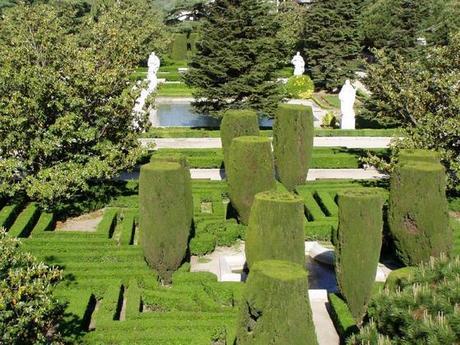Sabatini Gardens
Neoclassical-style garden in keeping with the Oriente Palace, which has given distinction to an area that in years gone by was used for a humbler purpose, i.e. the stables. While the new Oriente Palace was being built, the architects who were involved, first Sachetti and later Sabatini, designed gardens in the northern angle of the Palace. These were never built; instead, the space was used for the royal stables, which, in addition to the animals, housed the carriages and coaches that can now be seen in the Carriage Museum.
Today, a large, round fountain with tritons is at the intersection of the two major axes that are surrounded on all sides by quadrants and conifers, with trees arranged along the perimeter
Located on the north side, between the Royal Palace, the calle de Bailén and the cuesta de San Vicente. Of French design, are a monumental gardens created in the 30's of 20th century. Receive the name Sabatini because in this place were the stables built by the architect for service of the Palace. These gardens are adorned with a pond around which place some of the statues of Spanish kings who were originally intended to crown the Royal Palace. Geometrically sited between its rides, there are several fountains.
Francesco Sabatini was born in Palermo, he studied architecture in Rome. His first contacts with the Spanish monarchy was when he participated in the construction of the Palace of Caserta for the King of Naples and Duke of Parma and Tuscany, Charles VII, the future King Charles III of Spain. When he was raised to the Spanish throne, he called Sabatini to Madrid in 1760, where he was positioned above the most outstanding Spanish architects of the time. He was appointed as Great Master of Royal Works, with the rank of lieutenant colonel at the Engineers Corps, simultaneously designated also as an honorary academician of the Academia Real de Bellas Artes de San Fernando.
Sabatini's works are all encompassed within the neoclassicism tradition, but unlike other neoclassic authors, he was not inspired fundamentally by old Greece and Rome, but by the Italian Renaissance architecture.
His talent as an architect and the favor that was professed to him by the king brought many commissions of architectural work. His professional talents were awarded in many occasions. He was promoted to lieutenant general of the Engineers Corps, was granted the degree of Knight of the Order of Santiago, and had direct access to the circle of confidence of the king after his designation as gentilhombre de camara (Gentleman of the Royal Chamber).
Furthermore, Sabatini was responsible for building the Arms Factory of Toledo, the headquarters for the Wallon Guarda in Leganés (presently part of the Universidad Carlos III de Madrid), a convent in Valladolid (Santa Ana) and another one in Granada (Comendadoras of Santiago) and the well-known Chapel of the Immaculate in the Cathedral of Osma, also called of Palafox. He died at Madrid in 1792.
The Republican government ordered the seizure of different properties of the Spanish Royal Family, including this one, giving to the City Council of Madrid to build a public park. The project was awarded to Zaragozan architect Fernando García Mercadal after he win in the same held competition.
The gardens are adorned with numerous statues of Spanish kings who look quite at home in their green surroundings. As one should probably expect by now, therein lies another contradiction of sorts: the statues were actually never meant to be placed in the garden. There was simply not enough space for them at the Palacio Real, so the architects moved them here.
In 1933, clearing of the stable buildings was begun, and construction of the gardens begun, which were only completed in the late 1970s. The gardens have a formal Neoclassic style, consisting of well-sheared hedges, in symmetric geometrical patterns, adorned with a pool, statues and fountains, with trees also disposed in a symmetrical geometric shape. The statues are those of Spanish kings, not intended originally to even grace a garden, but originally crowding the adjacent palace. The tranquil array is a peaceful corner from which to view the palace.
The Sabatini Gardens are a perfect spot for a restful break during the exhausting sightseeing tours in Madrid. They offer spectacular views of the North façade of the Royal Palace, vegetal mazes, sculptures, a small reflecting pond and tons of tranquility. You can get there via flight to Madrid.



